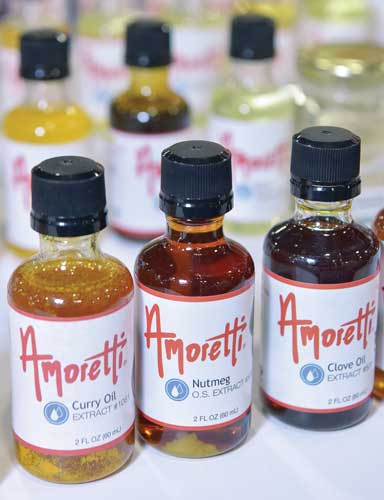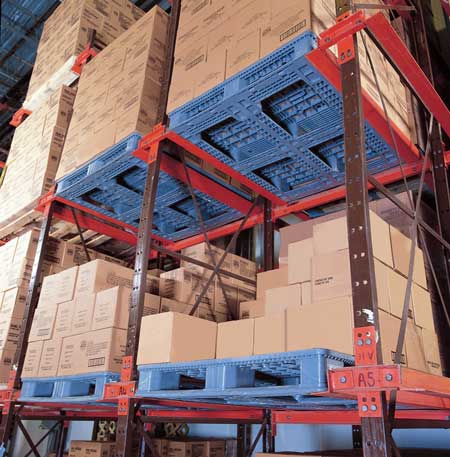Ingredient Packaging Close-Up
PACKAGING
Ingredient sourcing involves a complex chain of growers, processors, brokers, suppliers, and consolidators to reach food manufacturers. Packaging ingredients for this supply chain requires finesse. To meet customer needs, ingredient packaging facilitates distribution and ease of handling, deters and detects fraud, and decreases food safety risks.
A Complex Supply Chain
Damage and loss of ingredients during distribution impacts profitability and can interfere with food manufacturing as both can reduce quality and amount of ingredients. Within a distribution network, damage to ingredients can result from shock and vibration associated with truck, rail, boat, and air transportation; static load from warehouse stacking; impacts from drops; and environmental abuse from inappropriate temperature, humidity, or pathogen contamination. When ingredients are initially sold, both the product and its package are purchased. Distribution networks vary and packaging for one distribution network may not be suitable for another network. For example, shipping products among mountains such as the Rockies requires packaging with higher burst strength, and distributing ingredients in an active military situation requires unique packaging as specified by military packaging standards. To allow for the efficient distribution of ingredients, initial purchasers need to ensure that the product is adequately protected to withstand the expected distribution environment. For competitive reasons, exact distribution networks may be unknown to ingredient sources.
Ingredient purchasers define expectations, direct testing on existing packaging, and translate their customers’ packaging needs to ingredients suppliers. Distribution testing in the form of a laboratory, package-testing facility, or an actual distribution test is conducted by brokers/customers before products are received. Package changes can be made to align with a challenging distribution environment if needed. For example, if individual corrugated cases instead of entire pallet loads will be sent to customers, double-wall corrugation may be needed.
The increase in distribution of refrigerated or frozen ingredients presents an opportunity for packaging to add value. Monitors are used in the initial assessment of the reliability of a cold chain and to determine whether specified temperatures are exceeded during regular shipments. Intelligent packaging time-temperature monitors by Sensitech, MicroDAQ, and OMEGA are compliant with federal regulations and track the temperature of pallets/loads. Freeze indicators such as Fridge-tag by Berlinger and FreezeAlert by Sensitech are used to monitor ingredients that cannot be frozen. Use of temperature monitors facilitates rapid notification and corrective action. Real-time data tracking allows for products to be removed from the distribution system and new shipments initiated so that ingredient shortages do not occur. Time-temperature indicators on individual packaging build in confidence in the distribution of loads that are smaller than pallet-size. This ensures that product value is transferred.
 Deterring and Detecting Food Fraud
Deterring and Detecting Food Fraud
The complex network of ingredient sourcing excels in supply chain optimizations. Value chain elements are needed to ensure the validity of ingredient transfers within the supply. In the food industry, ingredient fraud is a major issue that involves fraudulent sources and diverting, substituting, or diluting ingredients. For example, an estimated 20% of Italian hard cheese sold in the United States is fraudulent. This represents a $375 million loss to the Italian cheese manufacturing industry. Other ingredients that rank high in fraudulent activity are olive oil, grains, honey, spices, and extracts. In the case of diversion and substitution, genuine ingredients are replaced with disingenuous ones, the ingredients are repacked, and a larger quantity of the now fraudulent ingredient is placed in the distribution system. Diversion can occur at many stages of the supply chain.
IFT’s Global Food Traceability Center emphasizes the value of improving traceability to reduce fraud. In this regard, systems such as the Focused Integration of Data for Early Signals (FIDES) software are valuable. When FIDES predicts a likely food fraud situation or identifies fraud, alerts are issued and systems are implemented to detect fraud for particular ingredients. Intelligent packaging is another way to deter ingredient fraud. As part of an incoming quality control process, intelligent packaging can efficiently authenticate ingredients in the supply chain. Such packaging solutions are often more efficient than product testing since the contaminant is often unknown and because factory inspections do not detect subsequent diversion. Bulk ingredient packaging focuses on maintaining the integrity of a trailer or pallet-size shipment so diversion and repacking of ingredients is deterred. This includes communication to supply chain entities such as printed shrink/stretch wrap in which letters, codes, or pictures applied at the ingredient source must align to demonstrate that pallet loads have not been tampered with. Further, wrapping a pallet with opaque film can be used to deter unwanted attention and resist identification by diverters. When a trailer, cargo hold, or pallet load is divided and sent to customers, the integrity of secondary and unit packaging is critical because the customer or consumer needs to be confident in the source and the value of the smaller package of ingredient being transferred.
Secondary packaging to deter and detect fraud includes hologram labels over package seams, radio frequency identification (RFID) tags, printed packaging, DNA molecular taggants, steganography, digital watermarks, and hidden codes. Once packaging is at the unit level and arrives to a production floor, it can be verified using overt or covert codes on the package. For example, Unisecure by Systech has variable microscopic variations embedded within existing print that employees on the production floor can authenticate by using a mobile app. Holo-graphic security on high-value and rare ingredients such as coco de mer, a nut found on only two islands among the Seychelles, has reduced counterfeiting. As track and trace systems in medical packaging advance with the serialization process, the costs of similar systems in the food industry is predicted to decrease. In addition, technology such as combined RFID and near-field communication chips by Securikett will provide authentication in the supply chain and opportunities to increase the value of ingredients.
Easing Production
Packaging can also facilitate ease of packaging disposal, formulation or mixing in package, and decreased risk of food safety issues. Packaging that readily complies with existing recycling, industrial composting, or reuse systems at food manufacturers is ideal. Communication on proper disposal is paramount between ingredient suppliers and their customers. Recycling focuses on single-layer polyethylene terephthalate, polyethylene, polypropylene, paper, glass, or metal. However, ingredients cannot always be packaged effectively in single-layer recyclable materials. This is because some ingredients contain critical compounds (such as concentrated aromas and flavors that absorb into polymers with low chemical resistance) and other products such as oils and dry spices that require exceptional oxygen or moisture barriers. Ingredients are increasingly being concentrated prior to distribution to reduce product water weight and reduce shipping costs. Because of this, packaging requirements have increased, and packaging materials with high chemical resistance in direct ingredient contact are needed. Structures such as these, which are multilayered, are not recyclable. But other packaging materials needed for structural support of the package are frequently recyclable. For example, refrigerated cheese requires polyvinylchloride or ethylene vinyl alcohol as an oxygen barrier and nylon for puncture resistance within a three- to five-layer polymer structure. To optimize packaging, a high-barrier bag is often placed within a corrugated box, which provides structural integrity. While a thin polymer bag cannot be recycled, the corrugated box can be recycled or reused.
 Reuse of packaging is increasing and this applies to plastic pallets, bins, barrels, and other containers used to transport ingredients that are frequently reordered and have a closed-loop supply chain. Ryan Roessler, product manager, ORBIS, explains the growing trend for reusable ingredient packaging: “Reusable packaging eases ingredient handling by reducing food safety risks associated with packaging, decreasing product loss due to distribution damage, improving operational efficiencies, as well as adding an element of sustainability for food manufacturers. For example, the ORBIS one-piece hygienic plastic pallet has a flow-through design that reduces ingredient or water pooling potential on the pallet. For direct food contact, [U.S. Food and Drug Administration]–compliant plastic blended with metal flake or barium sulfate (detectable by metal detectors or x-ray) ensures [that] potential plastic shavings do not contaminate product.” This adds a degree of safety not possible with wood pallets or fiber-based packaging, which could contaminate products without a food-ingredient manufacturer’s knowledge. Throughout the handoffs in the ingredients supply chain, reusable packaging has a growing role. For example, olive oil is commonly transported in bulk cargo holds, repackaged into trailer flexitanks or tanker trucks, and further separated into smaller reusable packaging such as plastic bins and pallets. “Because ORBIS rivets, adheres, or molds RFID tags and bar codes, product[s] can be tracked in distribution as well as within manufacturing facilities,” Roessler adds.
Reuse of packaging is increasing and this applies to plastic pallets, bins, barrels, and other containers used to transport ingredients that are frequently reordered and have a closed-loop supply chain. Ryan Roessler, product manager, ORBIS, explains the growing trend for reusable ingredient packaging: “Reusable packaging eases ingredient handling by reducing food safety risks associated with packaging, decreasing product loss due to distribution damage, improving operational efficiencies, as well as adding an element of sustainability for food manufacturers. For example, the ORBIS one-piece hygienic plastic pallet has a flow-through design that reduces ingredient or water pooling potential on the pallet. For direct food contact, [U.S. Food and Drug Administration]–compliant plastic blended with metal flake or barium sulfate (detectable by metal detectors or x-ray) ensures [that] potential plastic shavings do not contaminate product.” This adds a degree of safety not possible with wood pallets or fiber-based packaging, which could contaminate products without a food-ingredient manufacturer’s knowledge. Throughout the handoffs in the ingredients supply chain, reusable packaging has a growing role. For example, olive oil is commonly transported in bulk cargo holds, repackaged into trailer flexitanks or tanker trucks, and further separated into smaller reusable packaging such as plastic bins and pallets. “Because ORBIS rivets, adheres, or molds RFID tags and bar codes, product[s] can be tracked in distribution as well as within manufacturing facilities,” Roessler adds.
Increasingly, ingredient packaging is designed to be compatible with opening and dispensing machinery or other robotic food preparation processes. Making the ingredients easy to use is another means by which ingredient packaging adds value to food manufacturers. Packaging premeasured ingredients improves consistency in the final product. This is especially important with global brands that value product consistency even though their products are manufactured at multiple locations. Packets containing premeasured ingredients needed for batch sizes are common for sensitive ingredients such as baker’s yeast. Premeasured ingredients can also be enrobed within edible coatings and then added to batches without the need to open packages, measure ingredients, and dispose of packages. Both solutions reduce food safety risks associated with ingredient handling. When sizing for batches is not viable, packaging with features that can be resealed and reopened with gloved hands reduces the potential for cross-contamination. If production workers need to employ razor blades to efficiently open ingredient packages, this poses a safety risk. Easy-open packages with peelable seals or tear strips are a common solution.
Ingredient packaging that adds value by enabling the premix of ingredients before delivery to a food manufacturer is advancing. Delivering ingredient premixes closer to the finished product stage increases product consistency and reduces final production time. This can also preserve the integrity of minute and sensitive ingredients within the combined ingredient mix and requires less packaging overall. When ingredients degrade upon contact with other ingredients, packaging that allows for dispensing from different compartments within the same package is a solution.
 Claire Koelsch Sand, PhD, Contributing Editor
Claire Koelsch Sand, PhD, Contributing Editor
President, Packaging Technology and Research
Adjunct Professor, Michigan State Univ.
[email protected]
